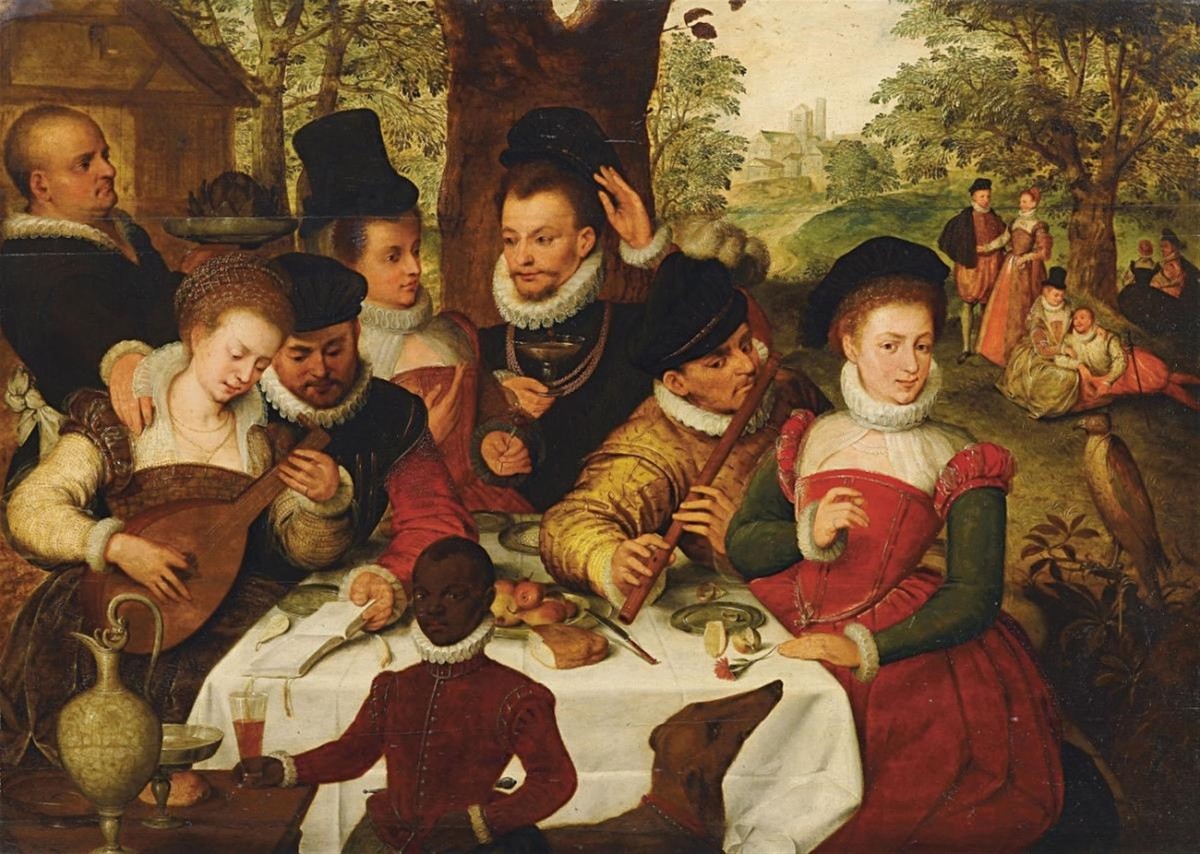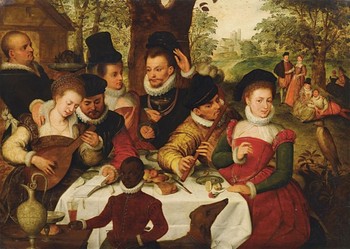Attributed to Frans Pourbus the Elder
A gallant company in the open air
Oil on panel : 81,5 X 113 cm
Unsigned
Sold at Lempertz Cologne, 21/11/09
For 246.000 €
This is a comparative item

Painting for Sale
In short
The moral intent of our painting, representing a brothel scene from the Bible, was easily recognizable for contemporary viewers: the Prodigal Son foolishly spent all his money before coming to his senses, the jester is commenting on his bad behaviour.
I found several panel paintings, three older ones and a younger one, with similar compositions or poses of the figures. Sadly none of them has a convincing attribution, nor do we know who might have made the original composition.
About the Parable of the Prodigal Son
The Prodigal Son, also known as the Lost Son, is one of the best known Parables of Jesus. It appears only in the Gospel of Luke, in the New Testament of the Bible. It is the third and final member of a trilogy, following the Parable of the Lost Sheep and the Parable of the Lost Coin.
The story is found in Luke 15:11-32. Jesus tells the story of a man who has two sons.
The younger, rebellious son, who rejects his father's upbringing, demands his share of his inheritance while his father is still living. Prideful and strong, the son goes off to a distant country where he leads a wild life of adventure, and squanders everything of value (literally and symbolically). Eventually he has to take work as a swine herder (clearly a low point, as swine are not kosher in Judaism). There, confronted with failure and despair, he comes to his senses, and determines to return home and throw himself on his father's mercy, repentant and willing to do anything to win back his father's favour.
To his surprise, and to the surprise of the others, his father greets him with open arms, and hardly gives him a chance to express his repentance; he kills a fatted calf to celebrate his return. No amount of time, no amount of money, and no amount of rebellion could get in the way of the father's patience and unconditional love for his son. The older brother becomes jealous at the favored treatment of his faithless brother and upset at the lack of reward for his own faithfulness: “For all these years I have been working like a slave for you, and I have never disobeyed your command; yet you have never given me even a young goat so that I might celebrate with my friends. But when this son of yours came back, who has devoured your property with prostitutes, you killed the fatted calf for him.”'
Then the father said to him, “Son, you are always with me, and all that is mine is yours. But we had to celebrate and rejoice, because this brother of yours was dead and has come to life; he was lost and has been found."
About our composition
Our composition holds five figures: the Prodigal Son is sitting between two female musicians playing transverse flute and theorbo, a maid is serving him a drink and at left stands a jester.
A similar painting is in the collection of the Museo Correr on Saint Mark’s Square in Venice. That painting must be a bit younger than ours, the background is different, only the face and left shoulder of the jester are visible and the still life on the table in the lower centre is of very poor quality.
The composition of these two paintings goes back onto an older model. Georges Marlier mentions in his monograph of Pieter Coecke van Aelst (1966, P. 375) three small round stained glass paintings representing the Parabel of the Prodigal Son, of which the compositions must go back to Pieter Coecke. There is only a photograph of one of them, but stylistically it does not stand close to our painting.
I did find three other older paintings, dating from the second quarter of the 16th century, with similar figures:
- in two almost identical large compositions of the Parable of the Prodigal Son, from the Fine Arts Museum of Budapest and of the Musée Carnavalet in Paris, one finds back the two same female musicians, while there is also the maid and the Prodigal Son. As Paris is represented in the background these two paintings might have been painted by a Flemish artist active in Paris. The Budapest version was in the past attributed to the Monogrammist of Brunswick, to Jan van Hemessen and to Jan Cornelisz. Vermeyen.
- A beautiful painting sold in July 2013 at Sotheby’s London represents a singing woman seated between the two female musicians, with the jester at left. Sotheby’s sold it as by the Master of the Female Half-Lengths, but the RKD at The Hague has refuted that attribution calling it “Anonymous painter from the S. Netherlands, 1st half 16th century”.
About our painting
The Parabel of the Prodigal Son formed at the same time a profound lesson and an excellent excuse for painters to represent flirting couples: their moralizing message was to keep away from such pleasures and excesses.
Contemporary viewers would easily have identified this merry company as a brothel scene. The bawd is pouring out a glass, while two of her prostitutes are playing music on appropriate instruments: a theorbo belongs to the lute family. In Dutch a lute is called a “luit”, which in those days was also slang for a vagina; her friend plays a flute … . As to the jester he is a commentator who inspirers the viewers to introspection; he knows the deeper motivations of man. Our self-knowledge will lead to repentance.
Why should you buy this painting?
Because there is more to this elegant merry company from the second half of the 16th century than meets the eye.
Comparative paintings
Click photos for more details

